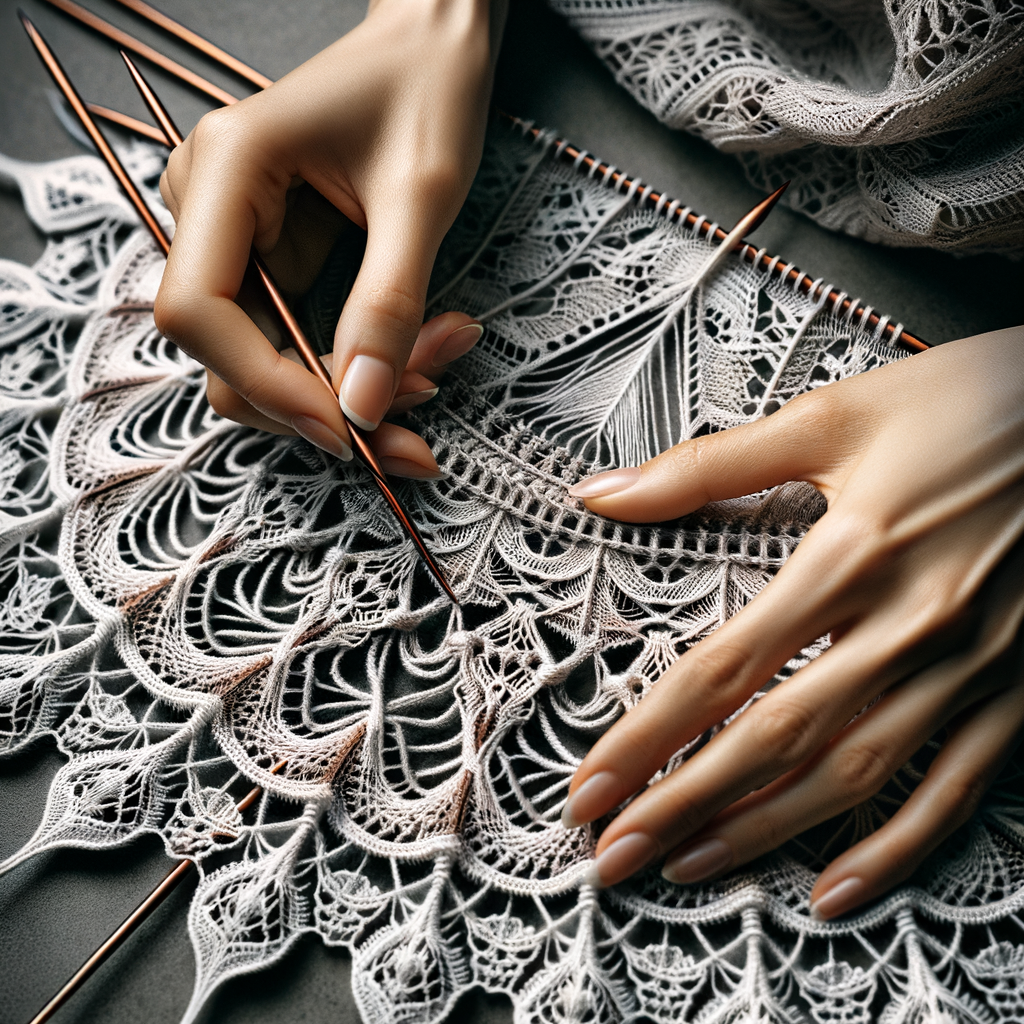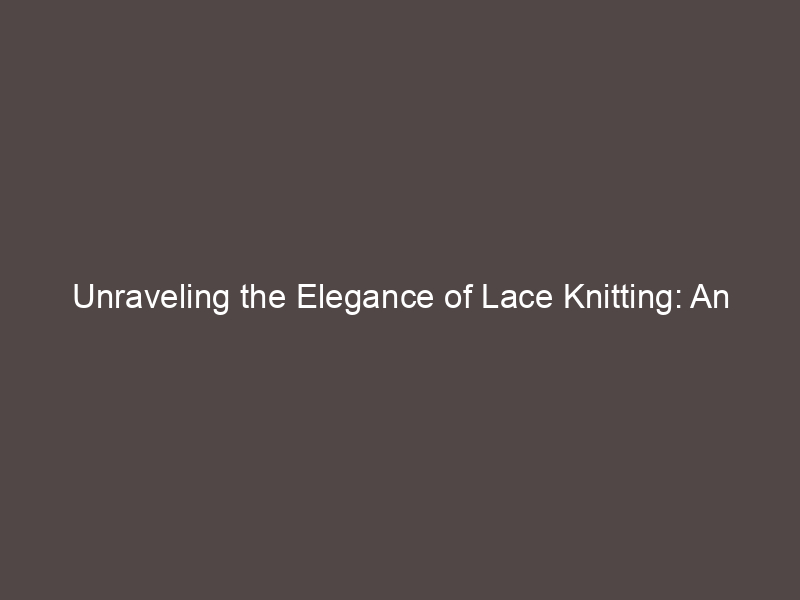
Introduction to Lace Knitting
Knitting is a craft that has been passed down through generations, and one of its most beautiful forms is lace knitting. This intricate style of knitting creates delicate and complex patterns that are a joy to behold. In this article, we will explore the beauty of lace knitting and understand why it is considered an intermediate skill.
- Understanding the Beauty of Lace Knitting
- Why Lace Knitting is Considered an Intermediate Skill
Lace knitting is a technique that involves creating holes in the fabric to form patterns. These patterns can range from simple geometric shapes to intricate floral designs. The beauty of lace knitting lies in its complexity and delicacy. Each stitch is carefully placed to create a pattern that is both visually stunning and structurally sound. It is a form of art that requires patience, precision, and creativity.
While knitting in general can be picked up by beginners, lace knitting is often considered an intermediate skill. This is because it involves a higher level of complexity and precision. Lace knitting requires the knitter to follow a chart or pattern, and often involves a variety of different stitches and techniques. It also requires a good understanding of tension and gauge, as any inconsistencies can significantly affect the final product. Despite these challenges, many knitters find the process of lace knitting to be incredibly rewarding and fulfilling.
In the following sections, we will delve deeper into the world of lace knitting, exploring the basics, intermediate techniques, and the beautiful patterns and designs that can be created. Whether you’re a seasoned knitter or a beginner looking to take on a new challenge, lace knitting offers a world of possibilities.
Lace Knitting Tutorial: The Basics
Embarking on the journey of lace knitting can be an exciting yet challenging experience. This tutorial will provide you with the basic knowledge you need to get started. We will cover the fundamental techniques of lace knitting and how to read lace knitting patterns.
Understanding Knitting Techniques
Before you can begin lace knitting, it’s important to understand the basic knitting techniques that are essential for this craft. Let’s dive into these techniques:
- Basic knitting techniques required for lace knitting
- Knit (K): This is the most basic stitch in knitting. It creates a flat, smooth fabric.
- Purl (P): This stitch is the opposite of the knit stitch. It creates a bumpy texture on the fabric.
- Yarn Over (YO): This technique is used to create holes in the fabric, which is a characteristic feature of lace knitting.
- Slip, Slip, Knit (SSK): This is a method of decreasing stitches. It creates a left-leaning decrease.
- Knit Two Together (K2Tog): This is another method of decreasing stitches. It creates a right-leaning decrease.
- How to read lace knitting patterns
- Understand the Symbols: Each symbol in a lace knitting pattern corresponds to a specific stitch or technique. Familiarize yourself with these symbols.
- Read from Right to Left: Unlike reading a book, lace knitting patterns are read from right to left.
- Pay Attention to Repeat Sections: Many lace patterns have sections that are repeated across the row. These are usually marked with a box or brackets.
- Practice with Simple Patterns: Start with simple lace patterns before moving on to more complex ones. This will help you get a feel for reading the patterns and executing the stitches.
There are several basic knitting techniques that you will need to master for lace knitting. These include:
Reading lace knitting patterns can be a bit tricky for beginners, but with practice, it becomes easier. Here are some tips:
Mastering these basic knitting techniques and understanding how to read lace knitting patterns will set a solid foundation for your lace knitting journey. Remember, practice makes perfect. So, grab your knitting needles and start practicing!
Intermediate Lace Knitting: Taking it a Step Further
Once you’ve mastered the basics of lace knitting, it’s time to take your skills to the next level. Intermediate lace knitting involves more complex patterns and techniques, but with patience and practice, you can create intricate and beautiful designs.
Advanced Knitting Tutorial: Preparing for Lace
Before diving into advanced lace knitting, there are two key areas you need to focus on. These are mastering the basic knitting techniques and learning to read advanced lace knitting patterns.
- Mastering the basic knitting techniques: Before you can tackle advanced lace knitting, you need to have a solid foundation in the basic knitting techniques. This includes understanding the different types of stitches, knowing how to cast on and off, and being able to maintain consistent tension in your work. Practice these techniques regularly to build your confidence and skill.
- Learning to read advanced lace knitting patterns: Lace knitting patterns can be complex, with many different stitches and techniques used in a single pattern. To successfully knit these patterns, you need to be able to read and understand them. Start with simpler patterns and gradually work your way up to more complex ones. Remember, practice makes perfect!
Intermediate lace knitting is a rewarding and creative endeavor. With time and practice, you’ll be able to create stunning pieces that showcase your advanced skills. So, grab your knitting needles and start practicing!
The Beauty of Lace Knitting: Exploring Patterns and Designs
Lace knitting is a beautiful and intricate art form. It’s all about creating delicate patterns and designs using just your knitting needles and some yarn. Whether you’re a beginner or an advanced knitter, there’s a lace pattern out there for you. Let’s explore some of these patterns, from simple to complex.
Lace Knitting Patterns: From Simple to Complex
There’s a wide range of lace knitting patterns available, suitable for different skill levels. They range from simple patterns that are perfect for intermediates, to complex designs that will challenge even the most advanced knitters. Let’s take a look at some examples.
- Examples of simple lace knitting patterns for intermediates
- The Feather and Fan Pattern: This is a classic lace knitting pattern that’s perfect for intermediates. It’s made up of just four rows, and creates a beautiful, wavy design.
- The Old Shale Pattern: Another simple lace pattern, the Old Shale creates a scalloped edge that’s perfect for blankets and scarves.
- The Diamond Lace Pattern: This pattern creates a series of diamond shapes, and is a great way to practice your yarn overs and decreases.
- Examples of complex lace knitting patterns for advanced knitters
- The Estonian Starflower Pattern: This intricate pattern is a real showstopper. It’s made up of a series of star-shaped flowers, and requires a lot of concentration and skill.
- The Japanese Feather Pattern: This is a complex pattern that creates a stunning, feather-like design. It’s not for the faint of heart, but the end result is well worth the effort.
- The Gothic Leaf Pattern: This pattern is a beautiful combination of leaves and lace, and is perfect for those who love nature-inspired designs.
For those who have mastered the basics of knitting and are ready to try something a little more challenging, simple lace patterns are a great next step. Here are a few examples:
For those who have been knitting for a while and are looking for a real challenge, complex lace patterns are the way to go. Here are a few examples:
Whether you’re an intermediate or an advanced knitter, lace knitting offers a world of possibilities. With a bit of practice and patience, you can create beautiful, intricate designs that are sure to impress.
Knitting for Intermediates: Mastering Lace Knitting
As you continue your journey in the world of lace knitting, you’ll find that there’s always more to learn. This section is dedicated to helping you master the intricate art of lace knitting. We’ll discuss common mistakes to avoid and provide practical tips to hone your skills.
Learn Lace Knitting: Practical Tips and Tricks
Understanding the nuances of lace knitting can be a game-changer in your knitting journey. Here are some practical tips and tricks to help you avoid common pitfalls and master the art of lace knitting.
- How to avoid common mistakes in lace knitting
- Practical tips for mastering lace knitting
One of the most common mistakes in lace knitting is losing track of your stitch count. This can lead to uneven patterns and a lot of frustration. To avoid this, always double-check your stitch count at the end of each row. Another common mistake is not using a lifeline. A lifeline is a piece of waste yarn that is threaded through the stitches of a row. If you make a mistake, you can rip back to the lifeline without losing any stitches. Always remember, practice makes perfect. Don’t be discouraged by mistakes, they’re part of the learning process.
Mastering lace knitting requires patience and practice. Here are some tips to help you along the way. First, choose the right yarn. Lace knitting looks best with thin, lightweight yarns. Second, use stitch markers. They can help you keep track of your pattern and make it easier to spot mistakes. Third, block your finished projects. Blocking is the process of wetting and shaping your knitted piece to give it the correct size and shape. It can make a big difference in the appearance of your lace knitting. Lastly, keep practicing. The more you knit, the better you’ll get.
Remember, the journey to mastering lace knitting is a marathon, not a sprint. Take your time, enjoy the process, and before you know it, you’ll be creating beautiful lace knits with ease and confidence.
Conclusion: The Elegance of Lace Knitting
As we reach the end of our journey through the world of lace knitting, it’s time to reflect on the elegance and beauty that this craft brings to the table. Lace knitting is not just a hobby, it’s an art form that requires patience, skill, and an eye for detail. It’s a testament to the creativity and dedication of knitters worldwide.
- Why lace knitting is considered an elegant art
- How mastering lace knitting can enhance your knitting skills
Lace knitting is considered an elegant art due to its intricate patterns and delicate designs. The process of creating a lace knit piece involves a high level of craftsmanship and attention to detail. Each stitch is carefully planned and executed to create an intricate pattern that is both beautiful and unique. The final product is a testament to the knitter’s skill and creativity, making it a truly elegant art form.
Mastering lace knitting can significantly enhance your knitting skills. It requires a deep understanding of different stitches and how they interact to create complex patterns. This knowledge can be applied to other forms of knitting, making you a more versatile and skilled knitter. Moreover, the patience and focus required for lace knitting can help improve your overall concentration and precision, skills that are valuable in many aspects of life.
In conclusion, lace knitting is a beautiful and elegant art form that can enhance your knitting skills and bring a sense of accomplishment and joy. Whether you’re a beginner or an experienced knitter, there’s always something new to learn and create in the world of lace knitting. So, pick up your needles and let your creativity flow!






